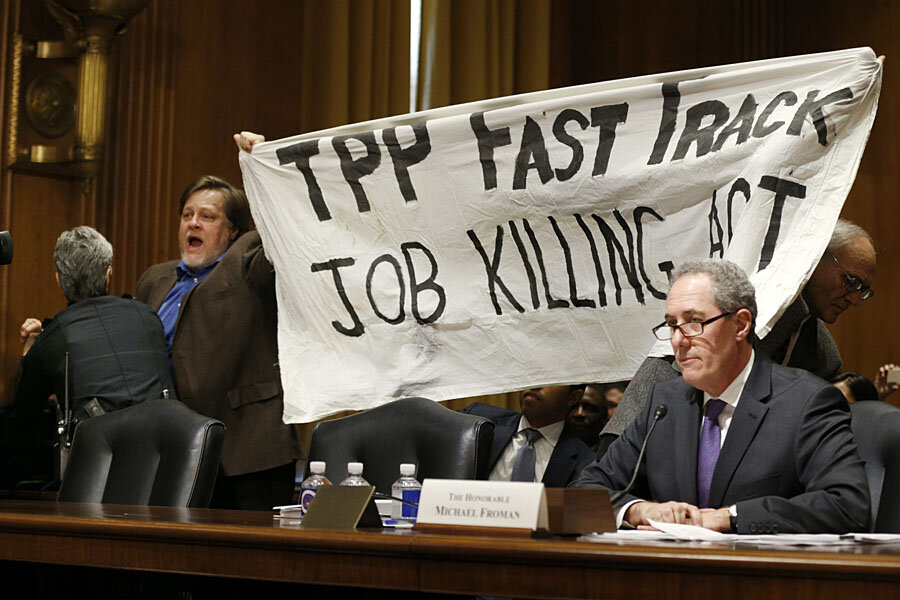How the Trans-Pacific Partnership could define President Obama's legacy
Loading...
The 12-nation free-trade pact, named the Trans-Pacific Partnership (TPP), came to agreement after five years of negotiations Monday. The largest trade accord since the North American Free Trade Agreement (NAFTA) took effect in 1994, the TPP could represent a “legacy-defining victory” for President Obama, should it successfully pass in Congress next year.
The pact initially began in the mid-2000s, when Brunei, Chile, New Zealand and Singapore began discussing a tiny regional trade pact. But in his last term, former President George W. Bush joined discussions and the agreement grew to eight nations.
The nationwide recession forced Mr. Obama to put negotiations on hold, but the United States re-joined the discussion in 2010. “The White House’s support helped draw in additional countries, including Japan, the world’s third-largest economy, whose entry in 2013 helped boost the global scale of the pact,” reported the Washington Post.
Today, the agreement seeks to interlock US, Canada, Japan, Australia, Brunei, Chile, Malaysia, Mexico, New Zealand, Singapore, Peru and Vietnam, which together account for 40 percent of the world’s gross domestic product.
TPP effectively eliminates tariffs between the member countries, “tear[s] down a host of non-tariff barriers and harmonize[s] all sorts of regulations.” According to the US Trade Representative’s website, TPP “will help increase Made-in-America exports, grow the American economy, support well-paying American jobs, and strengthen the American middle class.”
Described as a “‘historic agreement’ that addresses economic and international trade ‘challenges faced in the 21st century’” by US Trade Representative Michael B. Froman, the pact “helps define the rules of the road for the Asian-Pacific region,” reported the Washington Post.
For Obama, the deal could represent a historic effort to protect not only commerce, but the economy and the environment as well and specifically ensure US competitiveness amid a growing China.
In a speech at the United Nations in New York last week, Obama remarked, “We can promote growth through trade that meets a higher standard. And that’s what we’re doing through the Trans-Pacific Partnership.”
The “agreement will open markets while protecting the rights of workers and protecting the environment that enables development to be sustained,” Obama said.
By eliminating over 18,000 tariffs, Obama’s administration hopes the TPP will “make sure [US] farmers, ranchers, manufacturers, and small businesses can compete – and win – in some of the fastest-growing markets in the world.”
But opposition is widespread. Public Citizen, a nonprofit advocacy group that aims to “serve as the people’s voice in the nation’s capital,” claims TPP is a “massive, controversial” agreement “being pushed by big corporations”:
The TPP would expand the North American Free Trade Agreement (NAFTA) ‘trade’ pact model that has spurred massive US trade deficits and job loss, downward pressure on wages, unprecedented levels of inequality and new floods of agricultural imports ... The TPP not only replicates, but expands NAFTA's special protections for firms that offshore US jobs. And US TPP negotiators literally used the 2011 Korea FTA – under which exports have fallen and trade deficits have surged – as the template for the TPP.
While US officials have maintained that chapters in the agreement provide provisions for protecting worker and environmental rights, opponents are not convinced. “The deal could influence everything from the price of cheese to the cost of cancer treatments,” wrote Reuters.
With such potentially widespread impact, many are concerned as discussions have been kept behind closed doors. Pieces of the classified document have been leaked, and one particular provision has spurred controversy.
Known as the “Investor-State Dispute Settlement” (ISDS), the provision allows foreign investors to “bring claims for money damages over violations of the TPP’s investor protection provisions before a private arbitration tribunal that operates outside the challenged government’s court system,” reported the Atlantic.
TPP critics demand that the Obama administration prove the provision is constitutional, suggesting the provision could “undermine the structural protections that an independent federal judiciary was created to ensure.”
In an op-ed published by The Washington Post, Sen. Elizabeth Warren (D) of Massachusetts said the Trans Pacific Partnership “would undermine US sovereignty.” Yet she maintained that the alleged discrepancies of the TPP are not partisan.
In response, The United States Trade Representative’s Office "dismissed such concerns as overblown,” reported The New York Times. “Administration officials said opponents were using hypothetical cases to stoke irrational fear when an actual record exists that should soothe worries.”






